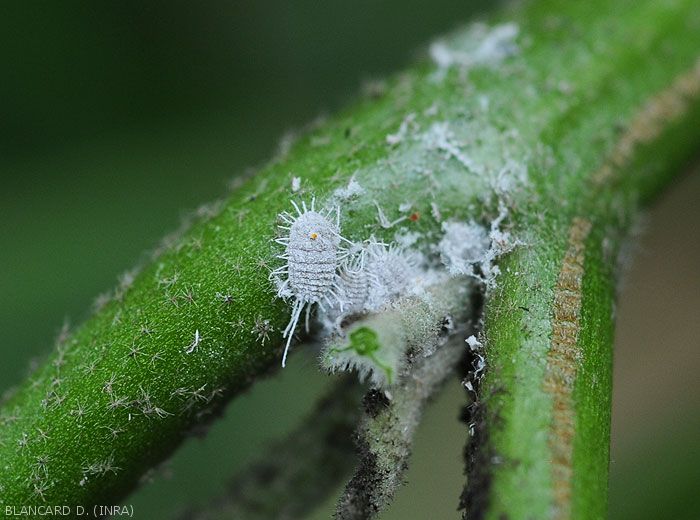
Mealybugs
(scale insects)
General
- Stinging-sucking insects belonging to the order Hemiptera and the superfamily Coccoideae.
- Several species parasitize vegetables, especially floury plants belonging to the Pseudococcidae family.
- They lack a horny shield (a kind of shell), and the body is usually covered with a white mealy secretion. They also have lateral waxy filaments clearly visible at the periphery of the body, and a cottony secretion containing the eggs can sometimes be noticed at the end of the abdomen.
- By way of example we will describe the characteristics of the species Pseudococcus viburni (Signoret) (syn. Pseudococcus affinis [Maskell]).
- Insects observed in open fields and under shelters.
Sensitive botanical family (s) * :
| Pseudococus sp. | Solanaceaees | Cucurbits |
| Paracoccus marginatus | Solanaceaes | Cucurbits |
| Phenacoccus gossypii | Solanaceaes | |
| Orthezia sp. | Solanaceaes |
Affected production area :
| Pseudococcus sp. | Mayotte | Reunion island |
| Guyana | New Caledonia | |
| French Polynesia | ||
| Paracoccus marginatus | Mayotte | Reunion island |
| Guyana | French Polynesia | |
| Phenacoccus gossypii | Reunion island | Guyana |
| Orthezia sp. | Guyana | |
Organs attacked
| Leaves | Fruits | Stems |
Symptoms, damage
- Symptoms :
- Reduced plant growth due to the numerous bites and food sucks exerted by the larvae and females of mealybugs present, especially on the stem.
- Deformation of the leaves which can be more or less curled, blistered, embossed, etc.
- Presence of honeydew and subsequently Fumagine covering the surface of the affected aerial organs (figures).
- Sooty mold, by reducing photosynthesis and respiration, causes yellowing and leaf damage. It also stains the fruits or alters their coloring, making them unmarketable (figure).
- Signs : Presence of larvae and adults on the affected organs (figures).
- Possible confusion :
Biology
- Development cycle : involves
- Eggs laid inside a white waxy ovisac.
- After hatching, the first instar larvae disperse on infested plants.
- After the second larval stage, this insect will form two successive false nymphs in which the males will undergo a metamorphosis.
- Adults, small winged midges whose life is ephemeral. Females, measuring 4 mm in length, do not undergo metamorphosis and therefore do not change shape. The pinkish color of their body is masked by white mealy wax.
- Dispersion : by plant material, but also by workers during cultivation operations, animals.
- P. viburni tolerates cold fairly well and overwinters as a non-diapausing nymph in the soil. It can be maintained on other alternative hosts, in particular on potato, apple tree, lemon tree, vine.
Protection
- Create a crawl space on the farm if the cochineal populations are important.
- Leach with water and treat the walls of shelters, posts, concrete walkways with an insecticide or a contact acaricide.
- Disinfect the equipment used in the greenhouse (drip system, boxes, etc.).
- Disinfect the reused substrate or soil.
- Produce the seedlings in an nursery insect-proof .
- Check the sanitary quality of the plants before and during their introduction into the crop or shelter.
- Remove and destroy infested plant debris and crop residues.
- Reason for chemical protection, in particular if you use auxiliaries or biopesticides , especially since most insecticides are not very effective on whiteflies.
- Treat plants before uprooting in the presence of high pest populations.





